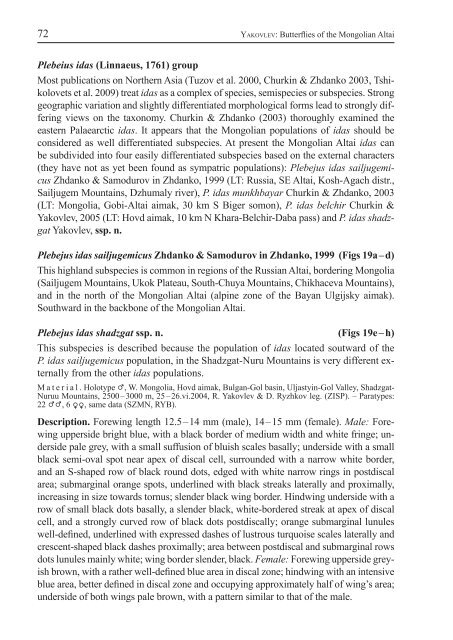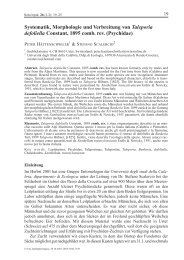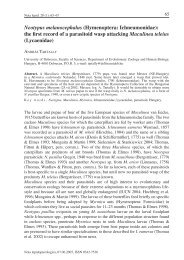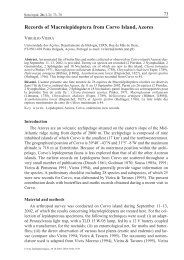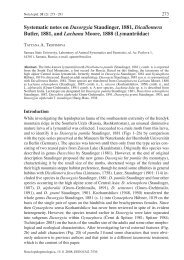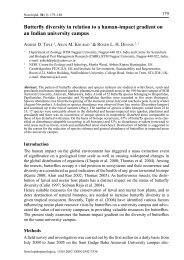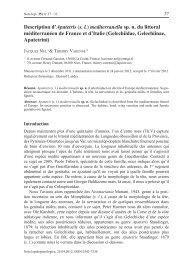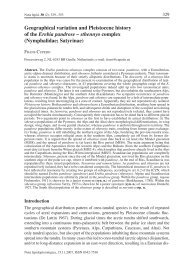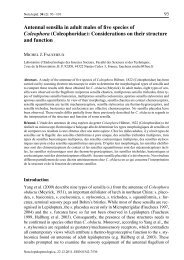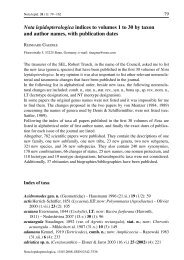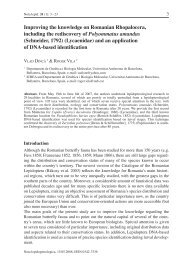Checklist of Butterflies (Papilionoidea) of the Mongolian Altai ...
Checklist of Butterflies (Papilionoidea) of the Mongolian Altai ...
Checklist of Butterflies (Papilionoidea) of the Mongolian Altai ...
You also want an ePaper? Increase the reach of your titles
YUMPU automatically turns print PDFs into web optimized ePapers that Google loves.
72 YAKOVLEV: <strong>Butterflies</strong> <strong>of</strong> <strong>the</strong> <strong>Mongolian</strong> <strong>Altai</strong><br />
Plebeius idas (Linnaeus, 1761) group<br />
Most publications on Nor<strong>the</strong>rn Asia (Tuzov et al. 2000, Churkin & Zhdanko 2003, Tshikolovets<br />
et al. 2009) treat idas as a complex <strong>of</strong> species, semispecies or subspecies. Strong<br />
geographic variation and slightly differentiated morphological forms lead to strongly differing<br />
views on <strong>the</strong> taxonomy. Churkin & Zhdanko (2003) thoroughly examined <strong>the</strong><br />
eastern Palaearctic idas. It appears that <strong>the</strong> <strong>Mongolian</strong> populations <strong>of</strong> idas should be<br />
considered as well differentiated subspecies. At present <strong>the</strong> <strong>Mongolian</strong> <strong>Altai</strong> idas can<br />
be subdivided into four easily differentiated subspecies based on <strong>the</strong> external characters<br />
(<strong>the</strong>y have not as yet been found as sympatric populations): Plebejus idas sailjugemicus<br />
Zhdanko & Samodurov in Zhdanko, 1999 (LT: Russia, SE <strong>Altai</strong>, Kosh-Agach distr.,<br />
Sailjugem Mountains, Dzhumaly river), P. idas munkhbayar Churkin & Zhdanko, 2003<br />
(LT: Mongolia, Gobi-<strong>Altai</strong> aimak, 30 km S Biger somon), P. idas belchir Churkin &<br />
Yakovlev, 2005 (LT: Hovd aimak, 10 km N Khara-Belchir-Daba pass) and P. idas shadzgat<br />
Yakovlev, ssp. n.<br />
Plebejus idas sailjugemicus Zhdanko & Samodurov in Zhdanko, 1999 (Figs 19a – d)<br />
This highland subspecies is common in regions <strong>of</strong> <strong>the</strong> Russian <strong>Altai</strong>, bordering Mongo lia<br />
(Sailjugem Mountains, Ukok Plateau, South-Chuya Mountains, Chikhaceva Mountains),<br />
and in <strong>the</strong> north <strong>of</strong> <strong>the</strong> <strong>Mongolian</strong> <strong>Altai</strong> (alpine zone <strong>of</strong> <strong>the</strong> Bayan Ulgijsky aimak).<br />
Southward in <strong>the</strong> backbone <strong>of</strong> <strong>the</strong> <strong>Mongolian</strong> <strong>Altai</strong>.<br />
Plebejus idas shadzgat ssp. n. (Figs 19e – h)<br />
This subspecies is described because <strong>the</strong> population <strong>of</strong> idas located soutward <strong>of</strong> <strong>the</strong><br />
P. idas sailjugemicus population, in <strong>the</strong> Shadzgat-Nuru Mountains is very different externally<br />
from <strong>the</strong> o<strong>the</strong>r idas populations.<br />
Material. Holotype P, W. Mongolia, Hovd aimak, Bulgan-Gol basin, Uljastyin-Gol Valley, Shadzgat-<br />
Nuruu Mountains, 2500 – 3000 m, 25 – 26.vi.2004, R. Yakovlev & D. Ryzhkov leg. (ZISP). – Paratypes:<br />
22 PP, 6 OO, same data (SZMN, RYB).<br />
Description. Forewing length 12.5 – 14 mm (male), 14 – 15 mm (female). Male: Forewing<br />
upperside bright blue, with a black border <strong>of</strong> medium width and white fringe; underside<br />
pale grey, with a small suffusion <strong>of</strong> bluish scales basally; underside with a small<br />
black semi-oval spot near apex <strong>of</strong> discal cell, surrounded with a narrow white border,<br />
and an S-shaped row <strong>of</strong> black round dots, edged with white narrow rings in postdiscal<br />
area; submarginal orange spots, underlined with black streaks laterally and proximally,<br />
increasing in size towards tornus; slender black wing border. Hindwing underside with a<br />
row <strong>of</strong> small black dots basally, a slender black, white-bordered streak at apex <strong>of</strong> discal<br />
cell, and a strongly curved row <strong>of</strong> black dots postdiscally; orange submarginal lunules<br />
well-defined, underlined with expressed dashes <strong>of</strong> lustrous turquoise scales laterally and<br />
crescent-shaped black dashes proximally; area between postdiscal and submarginal rows<br />
dots lunules mainly white; wing border slender, black. Female: Forewing upperside greyish<br />
brown, with a ra<strong>the</strong>r well-defined blue area in discal zone; hindwing with an intensive<br />
blue area, better defined in discal zone and occupying approximately half <strong>of</strong> wing’s area;<br />
underside <strong>of</strong> both wings pale brown, with a pattern similar to that <strong>of</strong> <strong>the</strong> male.


